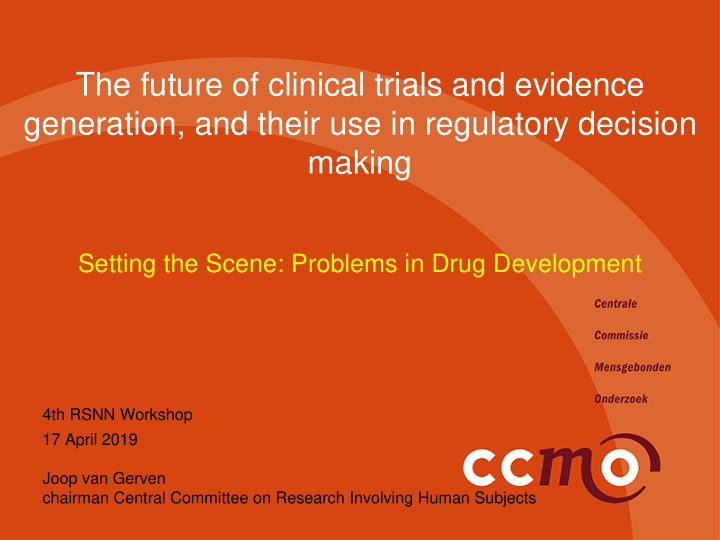



The future of clinical trials and evidence generation, and their use in regulatory decision making Setting the Scene: Problems in Drug Development 4th RSNN Workshop 17 April 2019 Joop van Gerven chairman Central Committee on Research Involving Human Subjects
Disclaimer This presentation represents personal views of Joop van Gerven, and not those of the CCMO.
Regulations don’t provide all required evidence - 3000 regularly applied therapies in clinical practice 1 - 41% proven efficacy - 8 % proven lack of efficacy - 51% insufficient evidence - >50% treatment guidelines based evidence levels 3-4 2 - 61% of medical specialists 3 : - ‘¼ of treatment decisions not based on scientific evidence’ 1 Clinical E vidence website 2011, how much of orthodox medicine is evidence based? 2007, Booz & Company analysis 2 https://www.demedischspecialist.nl/sites/default/files/rapport% 20zorgevaluatie% 20def.pdf 3 https://eenvandaag.avrotros.nl/fileadmin/editorial/docs/rapportonderzoekeenvandaagenomsevaluatieonderzoek.pdf
Providing evidence increasingly difficult: complex mechanisms and diseases - Orphan indications - small numbers - no placebo controls - children (ethical limits, interaction with development) - misuse of orphan drug status (use expansion) - Complex diseases - poorly understood diseases (psychiatry) - multifactorial conditions (geriatrics) - progressive diseases (neurology) - ‘Personalized medicine’ - molecular targeted therapies(oncology) - advanced-therapy medicines (cell/gene therapies) - Target-based indications - addressingcommon aspects of different diseases - crossing diagnostic boundaries (immunology)
Providing evidence increasingly difficult: limited practical significance - placebo-controlled - no comparisonswith available treatments - limited relevance for treatment decisions - trial selection criteria - limited representation of clinical population - groupwise effects - ‘number-needed-to-treat = 7’ --> ‘ineffective in 6 patients’ - no information on sources of variability - long-term results - prevention/early modification of slowly progressive disease - long-term safety data 1 Clinical E vidence website 2011, how much of orthodox medicine is evidence based? 2007, Booz & Company analysis 2 https://www.demedischspecialist.nl/sites/default/files/rapport% 20zorgevaluatie% 20def.pdf 3 https://eenvandaag.avrotros.nl/fileadmin/editorial/docs/rapportonderzoekeenvandaagenomsevaluatieonderzoek.pdf
Providing evidence increasingly difficult: rising costs and diminishing productivity http://www.appliedclinicaltrialsonline.com/are-we-dismissing-business-clinical-research https://www.clinicalleader.com/doc/surveying-the-clinical-cro-market-outsourcing-landscape-0001
Providing evidence increasingly difficult: increasingly complex regulations - Growing numbers of guidelines and regulations - 2014-2021: CTR, GDP R, MDR, IVDR - Complexity of requirements drains small innovative companies - academia---> small pharma---> large industry - CROs regulation €€€ E uropean community directives National authority €€ small pharma specialized CR Os services spin-offs quality P harmaceutical Industry procedures € academic research guideline Regulatory Body
Towards future solutions: changing drug development - improved regulatory guidance - harmonisation within regulatorory chains - sponsor control regulator control - facilitate academic drug development - alternative clinical research structures - adaptive/practical trial designs - improved drug research infrastructure/dedicated centres - ‘trial evidence’ ‘totality of evidence’ - building chain of consistent information: drug adminis tration target penetration pharmacological interaction pathophys iological effect clinical improvement - integrated throughout development process: preclinical phas e 1 phas e 2 phas e 3 health care evaluation - co-development of biomarkersof exposure and activity - real-world evidence and quality of life
Towards future solutions: changing health care - improved education and training of health care professionals - knowledge of molecular pathology/pathophysiology - knowledge of pharmacological targets - measurementsof above (biomarkers) - understandingof individual sources of variability - target-guided treatment decisions based on above - ‘trial-based guidelines’ --> ‘personalized medicine’ - learning health care systems - systematic evaluation of efficacy/safety as part of health care - based on systematic measurementsof drug-target interactions in relation to pathophysiological changes - includingreal-life (ambulant) measurements - comparative cost-effectiveness studies in health care - involve patients in treatment evaluation - treatment options include drugs in development - shared decision making on benefit/risk/burden - proportional information adapted to uncertainties - study design overlapswith clinical monitoring
Potential rewards - earlier access to new treatments - fewer late stage failures earlier re-allocation of resources - more practically relevant evidence - improved academic drug development environment - lower costs - more effective use of regulations - better trained health care professionals - optimised individual treatment - ...
Potential threats - less control - more/other/unknown safety risks? - real-world restrictions: - NL is small - international pharmaceutical industries/CROs - complicated health care systems - medical/scientific/educational limitations(reformsrequire knowledge) - legal/technological limitations(eP D, GDP R, IT, big data, etc ) - feasibility: can drug developers and prescribers change? - acceptability: can regulators change?
Recommend
More recommend